Best Algorithmic Trading Courses: A Comprehensive Guide



Editorial Note: While we adhere to strict Editorial Integrity, this post may contain references to products from our partners. Here's an explanation for How We Make Money. None of the data and information on this webpage constitutes investment advice according to our Disclaimer.
Best Algorithmic trading courses are:
Artificial Intelligence for Trading by Udacity
Executive Programme in Algorithmic Trading (EPAT) by QuantInsti
Advanced Trading Algorithms by Coursera
Algorithmic Trading and Stocks Essential Training by LinkedIn Learning
Quantitative Finance & Algorithmic Trading in Python by Udemy
Algorithmic trading involves using computer programs and software to execute trades based on pre-set rules and algorithms. This method allows for high-speed, precise, and emotionless trading, making it a preferred choice for many traders and financial institutions. But to learn this skill, you need to find a course you can rely on. And to help you in making that choice, we have reviewed the top ten algorithmic trading courses in this article.
Best algo trading courses
Learning algorithmic trading can be rewarding as it provides traders with the ability to capitalize on market opportunities efficiently. It offers benefits such as increased speed, reduced errors, and the ability to handle large volumes of trades simultaneously. The courses listed here are selected based on their content, instructor expertise, student reviews, and overall value.
Artificial Intelligence for trading by Udacity
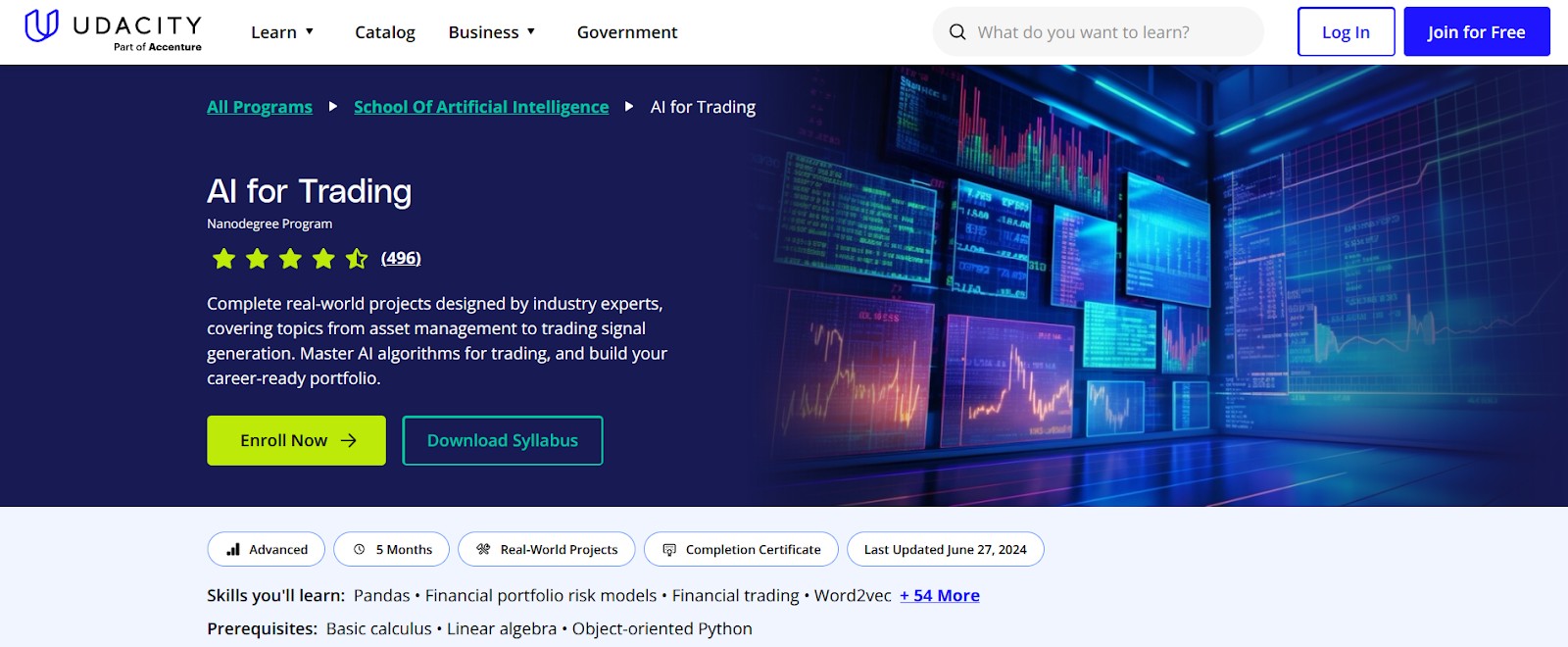 Artificial Intelligence for Trading by Udacity
Artificial Intelligence for Trading by UdacityThis nanodegree program focuses on the application of AI in quantitative trading. It covers topics like portfolio optimization, factor investing, sentiment analysis using natural language processing, signal processing, backtesting, and trade simulation. The program is project-based and includes mentor support and career services. However, keep in mind that it requires knowledge of basic calculus, linear algebra, and object-oriented Python.
Duration: Approximately 6 months
Price: $399 per month (typically around $2,394 for the full program)
Executive programme in algorithmic trading (EPAT) by QuantInsti
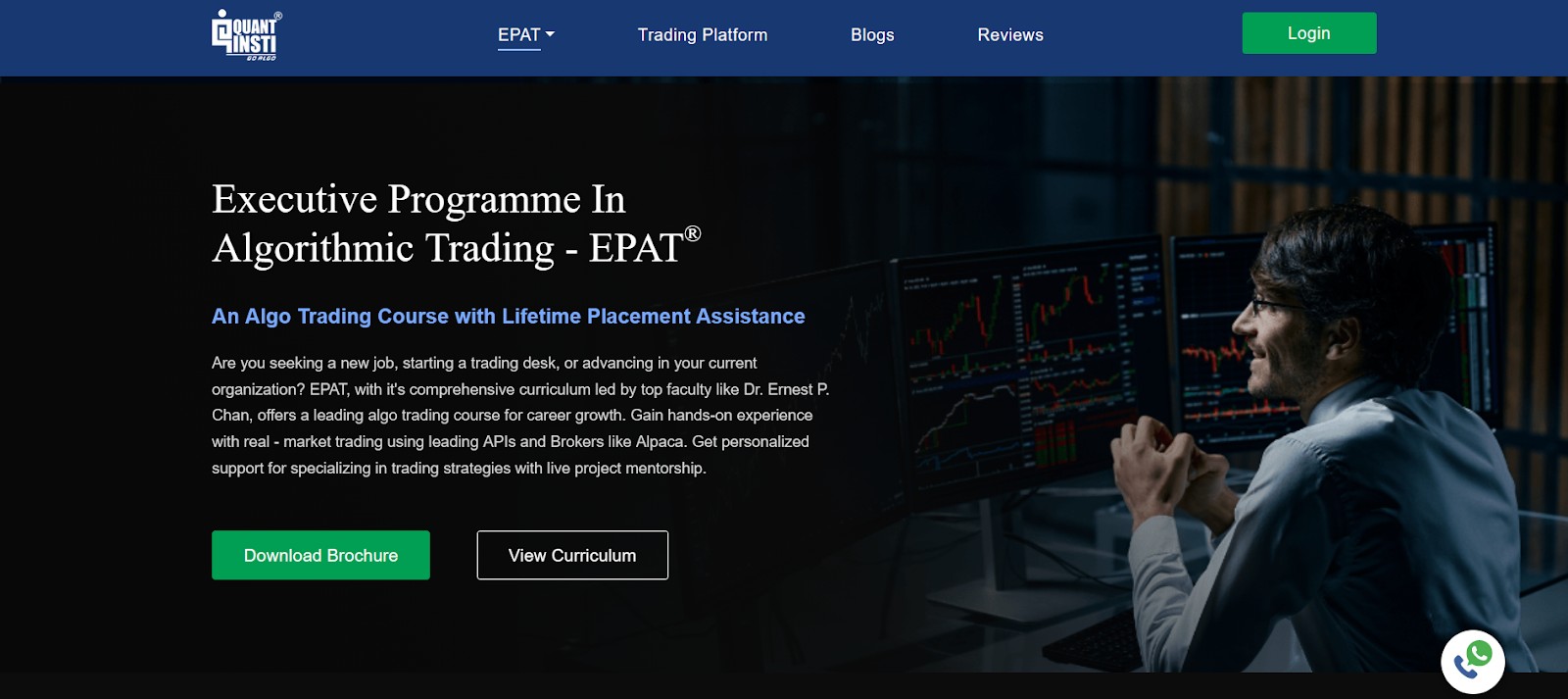 Executive Programme in Algorithmic Trading (EPAT) by QuantInsti
Executive Programme in Algorithmic Trading (EPAT) by QuantInstiA comprehensive program designed for professionals to advance their careers in algorithmic and quantitative trading. It includes live and recorded video lectures, sample codes, and career support. The program covers risk management, trading technologies, derivatives, quantitative strategies, and market microstructure.
Duration: 6 months
Price: $3,000 - $5,000 depending on the payment plan
Advanced trading algorithms by Coursera (ISB)
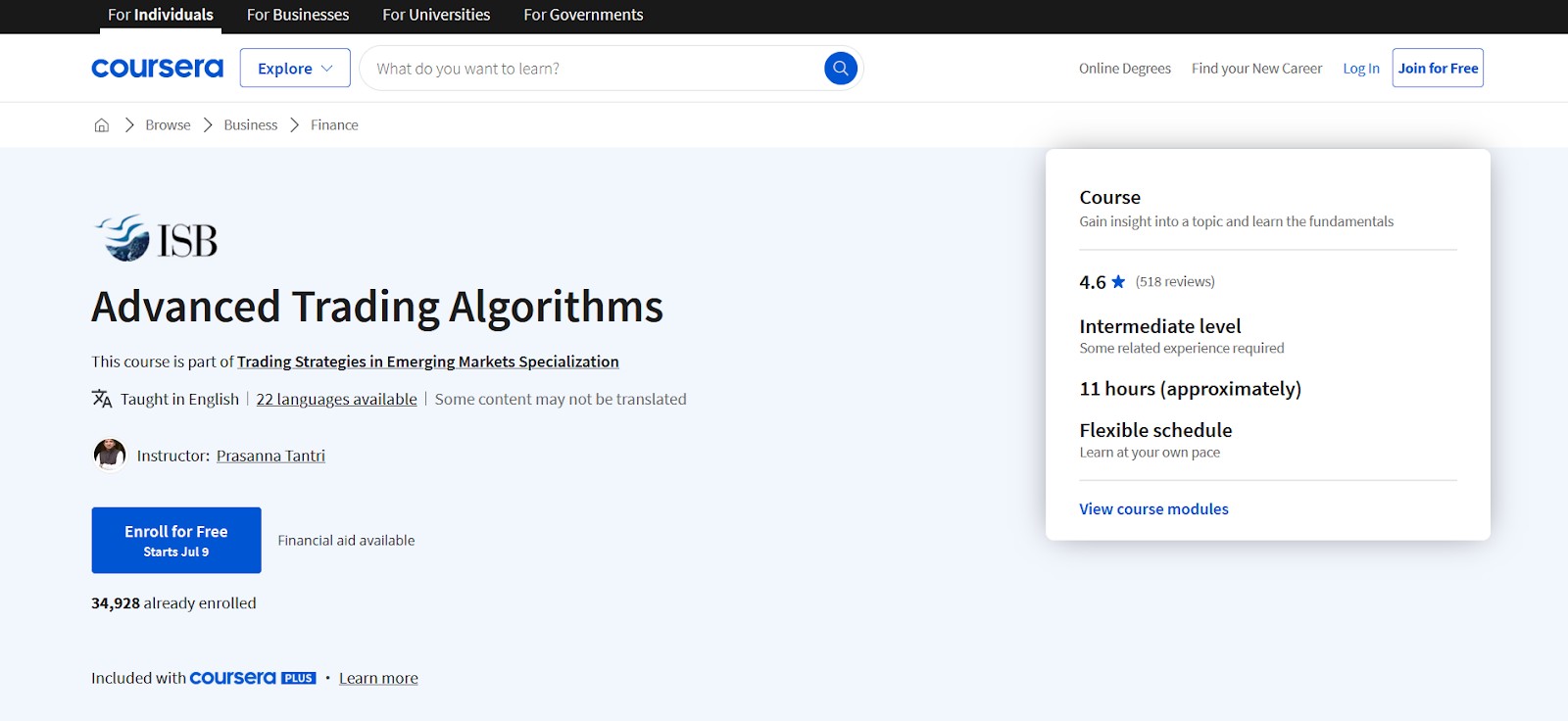 Advanced Trading Algorithms by Coursera (ISB)
Advanced Trading Algorithms by Coursera (ISB)This intermediate level course on Coursera, offered by the Indian School of Business, teaches scientific backtesting methods, differentiates data mining from solid empirical results, incorporates transaction costs, and uses risk-adjusted return metrics like Sharpe ratio. You will learn to build trading strategies based on accruals, beta, momentum, and G Score, gaining hands-on experience with backtesting and stress testing strategies.
Duration: 8 hours (excl. exercises)
Price: Free (with a fee for certification, typically around $49)
Algorithmic trading and stocks essential training by LinkedIn Learning
 Algorithmic Trading and Stocks Essential Training by LinkedIn Learning
Algorithmic Trading and Stocks Essential Training by LinkedIn LearningThis course will help you learn how to develop and back-test a rules-based trading strategy, and program a basic trading algorithm. It covers the fundamentals of securities markets, investing, and securities, including stocks, bonds, and derivatives. It includes practical steps for building and expanding trading algorithms, analyzing investing scenarios, and understanding trading relationships. Case studies and practical examples are also provided to illustrate algorithmic trading in action.
Duration: 2 hours 22 minutes
Price: Subscription-based, approximately $29.99 per month
Quantitative Finance & algorithmic trading in Python by Udemy
 Quantitative Finance & Algorithmic Trading in Python by Udemy
Quantitative Finance & Algorithmic Trading in Python by UdemyThis Udemy course covers stock market fundamentals, bonds, Markowitz Portfolio Theory, CAPM, derivatives, stochastic processes, the Black-Scholes model, and Value-at-Risk (VaR). You'll also learn about interest rate models, CDOs, and have a Python crash course included. The course focuses on understanding and implementing financial engineering models using Python, providing hands-on experience with real-world financial data and quantitative techniques.
Duration: 15 hours
Price: $129.99 (often available at discounted prices)
Algorithmic trading using Interactive Broker’s Python API by Udemy
 Algorithmic Trading using Interactive Broker’s Python API by Udemy
Algorithmic Trading using Interactive Broker’s Python API by UdemyThis course will teach you to automate trading strategies using Python, covering API trading, advanced Python concepts (OOP, multi-threading), data extraction, technical indicators, and end-to-end strategy deployment. It requires basic Python skills and intermediate finance/trading knowledge. It is specifically ideal for traders aiming to automate strategies on Interactive Brokers' platform.
Duration: 13 hours
Price: $129.99 (often available at discounted prices)
Forex algorithmic trading course: code a Forex Robot by Udemy
 Forex Algorithmic Trading Course: Code a Forex Robot by Udemy
Forex Algorithmic Trading Course: Code a Forex Robot by UdemyThis course teaches you how to build and code a Forex trading robot from scratch, covering topics such as the basics of algorithmic trading, writing and testing trading strategies, and using the MetaTrader 4 platform for automated trading. You'll gain practical coding skills to develop your own Forex trading algorithms and robots.
Duration: 11.5 hours
Price: $129.99 (often available at discounted prices)
Oxford algorithmic trading programme by Saïd Business School
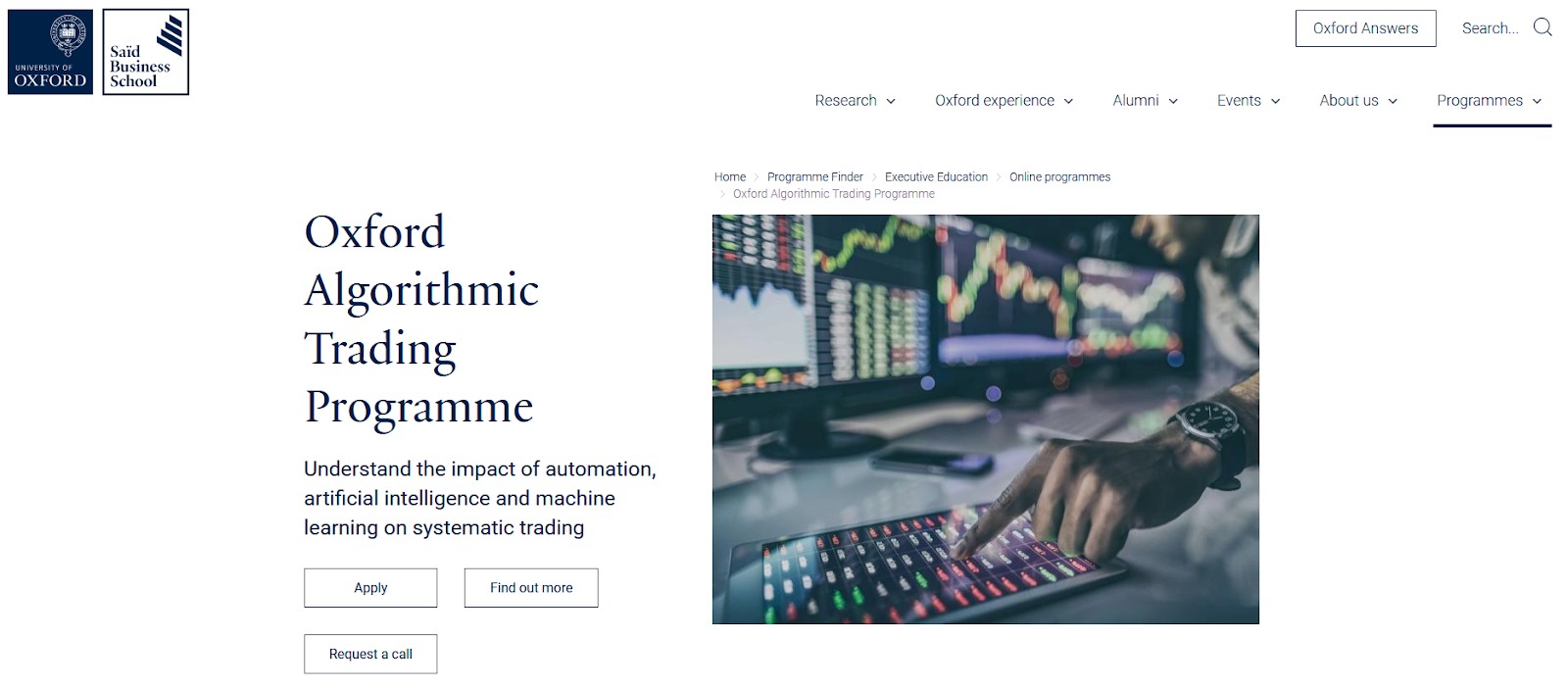 Oxford Algorithmic Trading Programme by Saïd Business School
Oxford Algorithmic Trading Programme by Saïd Business SchoolThis online program by the University of Oxford's Saïd Business School covers integrating AI, robo-advisers, and cryptocurrencies into trading, and includes modules on finance theory, systematic trading, technical analysis, and future trends. The programme also offers practical experience in building and evaluating trading models, guided by industry experts and Oxford faculty.
Duration: 6 weeks
Price: £1,995
Algorithmic trading strategies by WBS Training
 Algorithmic Trading Strategies by WBS Training
Algorithmic Trading Strategies by WBS TrainingThis course by World Business Strategies provides a deep dive into advanced trading strategies, machine learning impacts, and methods for researching new alpha sources. It covers topics like trend following, mean reversion, carry trading, portfolio strategies, and overfitting. Participants can earn CPD points upon completion.
Duration: 12 hours 45 minutes
Price: £199
Advanced technical analysis and algo trading strategies by University of Toronto
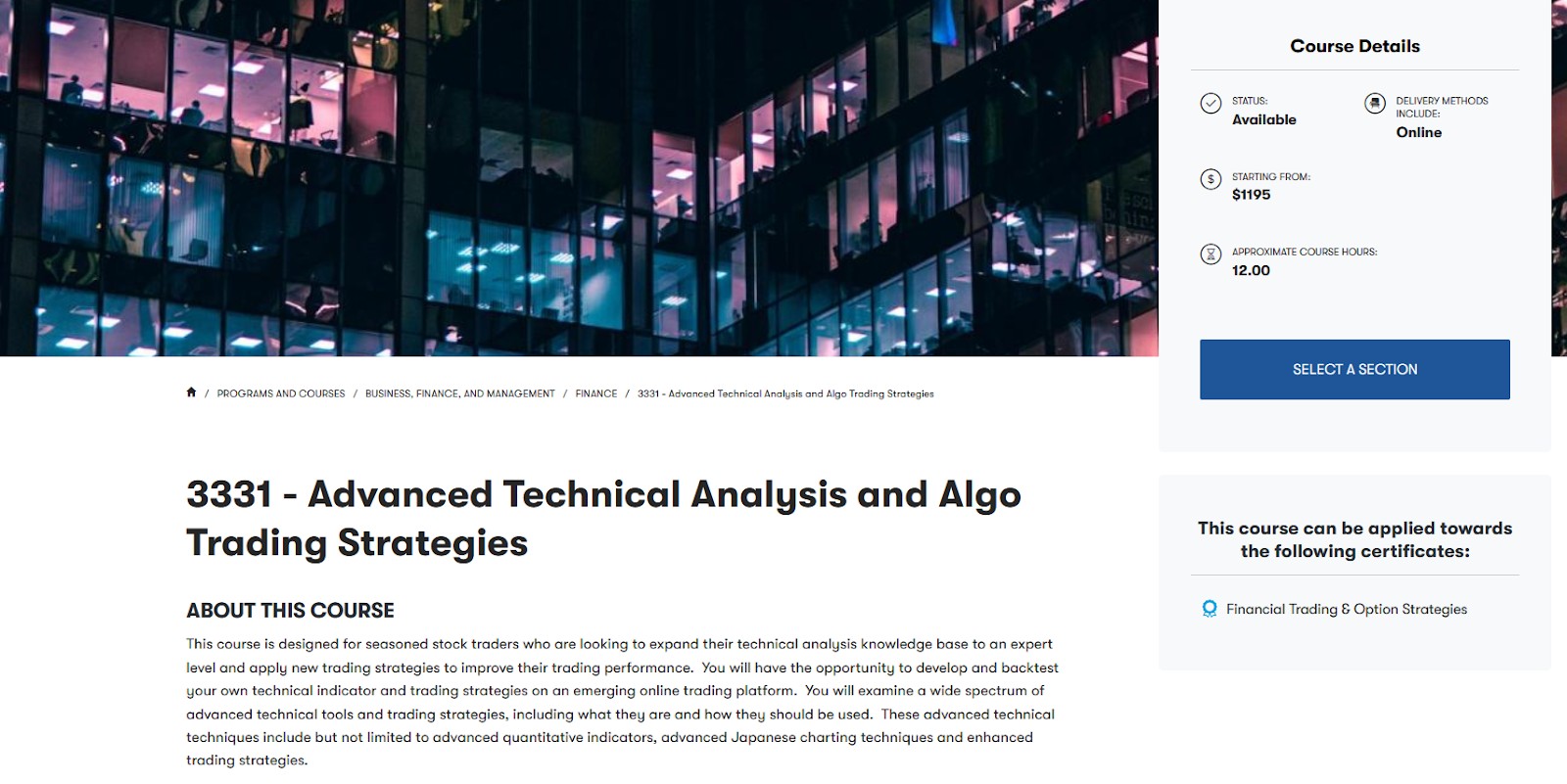 Advanced Technical Analysis and Algo Trading Strategies by University of Toronto
Advanced Technical Analysis and Algo Trading Strategies by University of TorontoThis course at the University of Toronto focuses on advanced charting techniques, quantitative analysis, and algorithmic trading strategies. It includes modules on financial market theories, technical indicators, backtesting, and risk management, providing practical skills for developing and implementing trading strategies.
Duration: 12 hours
Price: Starting from CAD 1195
Step-by-step guide to choosing the right course
Assessing your current skill level. Understanding your current knowledge and experience in trading and programming is crucial for selecting the appropriate course.
Defining your learning objectives. Set clear learning goals, whether you aim to understand the basics or master advanced strategies.
Comparing course features. Look for features such as comprehensive content, practical assignments, and support resources.
Checking instructor credentials. Research the qualifications and experience of course instructors to ensure they are experts in the field.
Evaluating course reviews. Read and interpret course reviews to gauge the experiences of past students.
Considering course cost and time commitment. Balance the cost of the course with the potential return on investment and the time required to complete the course.
Tips for traders
Foundational knowledge required. A basic understanding of computer science principles, particularly in algorithms and data structures, is required for most courses. Familiarity with statistical concepts and probability theory will also help you understand and develop trading models effectively.
Understanding financial markets and instruments. You should be familiar with different asset classes, such as stocks, bonds, and commodities, and understand how financial markets operate.
Choosing beginner-friendly courses. Look for courses that start with the basics and gradually progress to more advanced topics. Courses that offer hands-on projects, practical examples, and step-by-step instructions are particularly beneficial.
Using demo accounts for algo trading. Demo accounts simulate real trading environments, allowing you to test your algorithms and understand how they perform in different market conditions.
Choosing the right broker. The broker you choose can impact your trading journey significantly. Especially for algo trading, a certain set of capabilities is required with the broker you choose to trade with. We have compared the top options for this purpose below:
| Trading bots (EAs) | Demo | Min. deposit, $ | Max. leverage | Min Spread EUR/USD, pips | Max Spread EUR/USD, pips | Open an account | |
|---|---|---|---|---|---|---|---|
| Yes | Yes | 100 | 1:300 | 0,5 | 0,9 | Open an account Your capital is at risk. |
|
| Yes | Yes | No | 1:500 | 0,5 | 1,5 | Open an account Your capital is at risk.
|
|
| Yes | Yes | No | 1:200 | 0,1 | 0,5 | Open an account Your capital is at risk. |
|
| Yes | Yes | 100 | 1:50 | 0,7 | 1,2 | Study review | |
| Yes | Yes | No | 1:30 | 0,2 | 0,8 | Open an account Your capital is at risk. |
Important factors to consider when choosing a course
Accreditation and certification. Recognized certifications can significantly boost your resume, indicating that you have undergone rigorous training and are well-versed in the essential aspects of algorithmic trading.
Course curriculum and depth. A well-structured curriculum should cover a comprehensive range of topics relevant to algorithmic trading. Ensuring the course has sufficient depth means that you will gain a deep understanding of each topic, allowing you to apply your knowledge effectively in real-world trading scenarios.
Hands-on projects and practical experience. Look for courses that offer opportunities to work on real-world projects, use trading platforms, and engage in simulations. This practical experience is invaluable in building your confidence and competence as an algorithmic trader.
Support and community engagement. Community engagement can lead to valuable networking opportunities, collaborations, and continuous learning beyond the formal curriculum. Support from instructors and peers can also enhance your learning experience, helping you overcome challenges and stay motivated throughout the course.
Updates and lifetime access. Courses that offer lifetime access to their materials are particularly beneficial, as they allow you to revisit the content and stay updated with any new additions or revisions.
Accreditation and certification are key factors to look at
Having relied on countless courses for building my trading skillset, I can say that accreditation and certification are key factors to look at when making the final choice. Courses that are accredited by reputable institutions or offer recognized certifications can add significant value to your resume. They not only assure the quality of the content but also make you more attractive to potential employers or clients.
Also, practical experience is where the real learning happens. Ensure that the course you choose includes hands-on projects, trading simulations, and real-world applications. These practical components will help you understand how theoretical concepts play out in live trading environments.
Conclusion
Algorithmic trading involves using computer programs to execute trades based on pre-set rules, allowing for high-speed and precise trading. To learn this skill, choosing the right course becomes essential. Consider courses with reputable accreditations and certifications, as they add value to your resume. Practical experience is also important, so look for courses offering hands-on projects and real-world applications.
FAQs
Can I start learning algorithmic trading without any prior programming experience?
Yes, you can start learning algorithmic trading without prior programming experience, but it's advisable to gain basic programming skills, especially in Python, to fully grasp the concepts and practical applications.
How much time should I dedicate weekly to complete an algorithmic trading course?
On average, dedicating 5-10 hours per week is sufficient to complete an algorithmic trading course, though this can vary depending on the course complexity and your prior knowledge.
Are there free resources available for learning algorithmic trading?
Yes, there are many free resources available, including online tutorials, forums, and open-source platforms. However, structured courses often provide a more comprehensive and guided learning experience.
Can algorithmic trading be applied to all financial markets?
Yes, algorithmic trading can be applied to various financial markets, including stocks, forex, commodities, and cryptocurrencies. Each market has its own dynamics, so it's essential to adapt your strategies accordingly.
Related Articles
Team that worked on the article
Parshwa is a content expert and finance professional possessing deep knowledge of stock and options trading, technical and fundamental analysis, and equity research. As a Chartered Accountant Finalist, Parshwa also has expertise in Forex, crypto trading, and personal taxation. His experience is showcased by a prolific body of over 100 articles on Forex, crypto, equity, and personal finance, alongside personalized advisory roles in tax consultation.
Chinmay Soni is a financial analyst with more than 5 years of experience in working with stocks, Forex, derivatives, and other assets. As a founder of a boutique research firm and an active researcher, he covers various industries and fields, providing insights backed by statistical data. He is also an educator in the field of finance and technology.
As an author for Traders Union, he contributes his deep analytical insights on various topics, taking into account various aspects.
Mirjan Hipolito is a journalist and news editor at Traders Union. She is an expert crypto writer with five years of experience in the financial markets. Her specialties are daily market news, price predictions, and Initial Coin Offerings (ICO).
Crypto trading involves the buying and selling of cryptocurrencies, such as Bitcoin, Ethereum, or other digital assets, with the aim of making a profit from price fluctuations.
Algorithmic trading is an advanced method that relies on advanced coding and formulas based on a mathematical model. However, compared to traditional trading methods, the process differs by being automated.
Diversification is an investment strategy that involves spreading investments across different asset classes, industries, and geographic regions to reduce overall risk.
Backtesting is the process of testing a trading strategy on historical data. It allows you to evaluate the strategy's performance in the past and identify its potential risks and benefits.
Yield refers to the earnings or income derived from an investment. It mirrors the returns generated by owning assets such as stocks, bonds, or other financial instruments.






























































































































